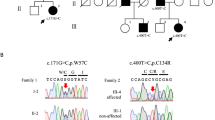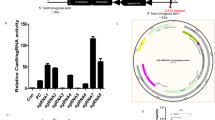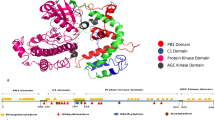Abstract
Spinocerebellar ataxia type 14 (SCA14) is an autosomal dominant neurodegenerative disorder, first described in a Japanese family, showing linkage to chromosome 19q13.4-qter. Recently, mutations have been identified in the PRKCG gene in families with SCA14. The PRKCG gene encodes the protein kinase Cγ (PKCγ), a member of a serine/threonine kinase family involved in signal transduction important for several cellular processes, including cell proliferation and synaptic transmission. To identify the disease-causing mutation in a large group of ataxia patients, we searched for mutations in the PRKCG gene. We ascertained 366 unrelated patients with spinocerebellar ataxia, either pure or with associated features such as epilepsy, mental retardation, seizures, paraplegia, and tremor. A C-to-G transversion in exon 4, resulting in a histidine-to-glutamine change at codon 101 of the PKCγ protein, was identified in patients from a family with slowly progressive pure cerebellar ataxia. Functional studies performed in HEK293 cells transfected with normal or mutant construct showed that this mutation affects PKCγ stability or solubility, verified by time-dependent decreased protein levels in cell culture. In conclusion, the H101Q mutation causes slowly progressive uncomplicated ataxia by interfering with PKCγ stability or solubility, which consequently may cause in either case a decrease in the overall PKCγ-dependent phosphorylation.
Similar content being viewed by others
Log in or create a free account to read this content
Gain free access to this article, as well as selected content from this journal and more on nature.com
or
References
Alonso I, Barros J, Tuna A, Coelho J, Sequeiros J, Silveira I, Coutinho P (2003) Phenotypes of spinocerebellar ataxia type 6 and familial hemiplegic migraine caused by a unique CACNA1A missense mutation in patients from a large family. Arch Neurol 60:610–614
Brkanac Z, Bylenok L, Fernandez M, Matsushita M, Lipe H, Wolff J, Nochlin D, Raskind WH, Bird TD (2002) A new dominant spinocerebellar ataxia linked to chromosome 19q13.4-qter. Arch Neurol 59:1291–1295
Chen C, Kano M, Abeliovich A, Chen L, Bao S, Kim JJ, Hashimoto K, Thompson RF, Tonegawa S (1995) Impaired motor coordination correlates with persistent multiple climbing fiber innervation in PKC gamma mutant mice. Cell 83:1233–1242
Chen DH, Brkanac Z, Verlinde CL, Tan XJ, Bylenok L, Nochlin D, Matsushita M, Lipe H, Wolff J, Fernandez M, Cimino PJ, Bird TD, Raskind WH (2003) Missense mutations in the regulatory domain of PKC gamma: a new mechanism for dominant nonepisodic cerebellar ataxia. Am J Hum Genet 72:839–849
Chen DH, Cimino PJ, Ranum LP, Zoghbi HY, Yabe I, Schut L, Margolis RL, Lipe HP, Feleke A, Matsushita M, Wolff J, Morgan C, Lau D, Fernandez M, Sasaki H, Raskind WH, Bird TD (2005) The clinical and genetic spectrum of spinocerebellar ataxia 14. Neurology 64:1258–1260
Coussens L, Parker PJ, Rhee L, Yang-Feng TL, Chen E, Waterfield MD, Francke U, Ullrich A (1986) Multiple, distinct forms of bovine and human protein kinase C suggest diversity in cellular signaling pathways. Science 233:859–866
Knopf JL, Lee MH, Sultzman LA, Kriz RW, Loomis CR, Hewick RM, Bell RM (1986) Cloning and expression of multiple protein kinase C cDNAs. Cell 46:491–502
Mellor H, Parker PJ (1998) The extended protein kinase C superfamily. Biochem J 332:281–292
Newton AC (2003) Regulation of the ABC kinases by phosphorylation: protein kinase C as a paradigm. Biochem J 370:361–371
Orita M, Suzuki Y, Sekiya T, Hayashi K (1989) Rapid and sensitive detection of point mutations and DNA polymorphisms using the polymerase chain reaction. Genomics 5:874–879
Quest AF, Bardes ES, Bell RM (1994) A phorbol ester binding domain of protein kinase C gamma. Deletion analysis of the Cys 2 domain defines a minimal 43-amino acid peptide. J Biol Chem 269:2961–2970
Sambrook J, Fritsch EF, Maniatis T (1989) Molecular cloning: a laboratory manual. Cold Spring Harbor Laboratory Press, Cold Spring Harbor, NY
Schols L, Bauer P, Schmidt T, Schulte T, Riess O (2004) Autosomal dominant cerebellar ataxias: clinical features, genetics and pathogenesis. Lancet Neurol 3:291–304
Seki T, Adachi N, Ono Y, Mochizuki H, Hiramoto K, Amano T, Matsubayashi H, Matsumoto M, Kawakami H, Saito N, Sakai N (2005) Mutant protein kinase C gamma found in spinocerebellar ataxia type 14 is susceptible to aggregation and cause cell death. J Biol Chem 280(32):29096–29106
Stevanin G, Hahn V, Lohmann E, Bouslam N, Gouttard M, Soumphonphakdy C, Welter ML, Ollagnon-Roman E, Lemainque A, Ruberg M, Brice A, Durr A (2004) Mutation in the catalytic domain of protein kinase C gamma and extension of the phenotype associated with spinocerebellar ataxia type 14. Arch Neurol 61:1242–1248
Tanaka C, Nishizuka Y (1994) The protein kinase C family for neuronal signaling. Annu Rev Neurosci 17:551–567
van de Warrenburg BP, Verbeek DS, Piersma SJ, Hennekam FA, Pearson PL, Knoers NV, Kremer HP, Sinke RJ (2003) Identification of a novel SCA14 mutation in a Dutch autosomal dominant cerebellar ataxia family. Neurology 61:1760–1765
Verbeek DS, Knight MA, Harmison GG, Fischbeck KH, Howell BW (2005) Protein kinase C gamma mutations in spinocerebellar ataxia 14 increase kinase activity and alter membrane targeting. Brain 128:436–442
Yabe I, Sasaki H, Chen DH, Raskind WH, Bird TD, Yamashita I, Tsuji S, Kikuchi S, Tashiro K (2003) Spinocerebellar ataxia type 14 caused by a mutation in protein kinase C gamma. Arch Neurol 60:1749–1751
Yamashita I, Sasaki H, Yabe I, Fukazawa T, Nogoshi S, Komeichi K, Takada A, Shiraishi K, Takiyama Y, Nishizawa M, Kaneko J, Tanaka H, Tsuji S, Tashiro K (2000) A novel locus for dominant cerebellar ataxia (SCA14) maps to a 10.2-cM interval flanked by D19S206 and D19S605 on chromosome 19q13.4-qter. Ann Neurol 48:156–163
Zeidman R, Pettersson L, Sailaja PR, Truedsson E, Fagerstrom S, Pahlman S, Larsson C (1999) Novel and classical protein kinase C isoforms have different functions in proliferation, survival and differentiation of neuroblastoma cells. Int J Cancer 81:494–501
Acknowledgements
We thank all patients and their family members for cooperation, Prof. António Amorim for providing control DNA samples, and Nurse Helena Cardoso for collecting samples. We would also like to thank Dr. S.M. Prescott and Dr. M.K. Topham for kindly providing the PKCγ construct, Prof. Carlos Duarte for the suggestions and careful reading of this manuscript, and Victor Mendes for image technical assistance. This work was supported by research grants POCTI/MGI/34517/00, Financiamento Plurianual de Unidades de Investigação, all from FCT (Fundação para a Ciência e Tecnologia) and FEDER. I.A. and A.I.S. are recipients of scholarships from FCT, Portugal.
Author information
Authors and Affiliations
Corresponding author
Rights and permissions
About this article
Cite this article
Alonso, I., Costa, C., Gomes, A. et al. A novel H101Q mutation causes PKCγ loss in spinocerebellar ataxia type 14. J Hum Genet 50, 523–529 (2005). https://doi.org/10.1007/s10038-005-0287-z
Received:
Accepted:
Published:
Issue date:
DOI: https://doi.org/10.1007/s10038-005-0287-z
Keywords
This article is cited by
-
Spinocerebellar ataxias (SCAs) caused by common mutations
neurogenetics (2021)
-
‘Medusa head ataxia’: the expanding spectrum of Purkinje cell antibodies in autoimmune cerebellar ataxia. Part 2: Anti-PKC-gamma, anti-GluR-delta2, anti-Ca/ARHGAP26 and anti-VGCC
Journal of Neuroinflammation (2015)
-
Spectrum and prevalence of autosomal dominant spinocerebellar ataxia in Hokkaido, the northern island of Japan: a study of 113 Japanese families
Journal of Human Genetics (2007)
-
Mutation of the highly conserved cysteine residue 131 of the SCA14 associated PRKCG gene in a family with slow progressive cerebellar ataxia
Journal of Neurology (2006)



